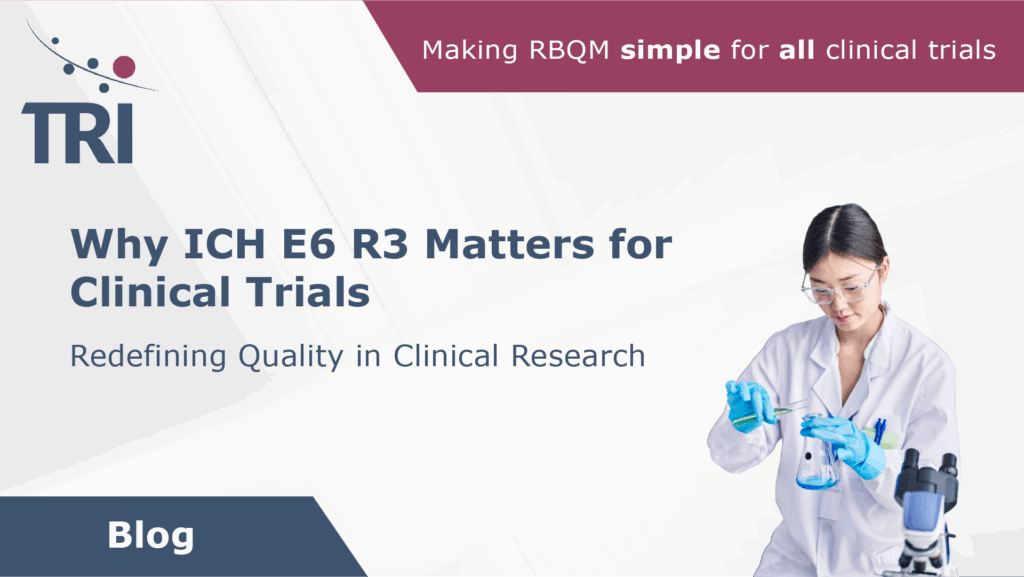Why ICH E6 R3 Matters for Clinical Trials

The Urgency to Rethink Everything
There’s a quiet but clear shift happening in clinical research. It’s not about decentralization. It’s not about automation. It’s not even about speed, though all of those play a role.
It’s about something more foundational: the way we think about quality, risk, and the systems we’ve come to rely on.
The guidance for ICH E6 (R3) lands right in the middle of this shift. But this isn’t just another regulatory update. It’s a fork in the road. One path leads to smarter trials built on design, intention, and transparency. The other sticks with old habits, ones that were already strained long before the pandemic forced us to rethink how we conduct research.
If we’re honest, many of the systems and metrics we use today are optimized for a version of clinical trials that no longer exists.
So, where does E6 (R3) fit into this moment?
It forces us to confront a difficult but necessary question: are we building trials that work, or trials that simply comply?
E6 R3 Demands Maturity
One of the most important things E6 (R3) does is elevate Quality by Design (QbD) and Risk-Based Quality Management (RBQM) from suggestions to expectations. In doing so, it exposes a longstanding gap in the industry, not in tools or frameworks, but in mindset.
Let’s be clear: most sponsors already have some version of risk assessment or quality oversight in place. But too often, these are reactive steps, layered on late in the process, driven more by inspection-readiness than strategic value.
What E6 (R3) proposes is different. It treats quality and risk as integral design considerations. That difference may seem subtle on paper. In practice, it requires a redesigning of how trials are built, monitored and evaluated. It embeds quality and risk into the foundation of trial design.
QbD is a Way of Thinking
QbD often fails not because the framework is flawed, but because the organizational culture isn’t ready. Real QbD means asking hard questions early – about endpoint definitions, protocol practicality, patient burden, and tolerance.
When QbD is treated as a procedural requirement, it ends up as a PowerPoint deck. When it’s treated as a mindset, it changes the entire trajectory of a trial.
ICH E6 (R3) gets this right. It pushes for thoughtful risk identification, pragmatic control strategies, and continuous oversight. But that flexibility only works if the people implementing it are willing to own the hard thinking, not just the documentation.
This is especially evident in Annex 1, Section 3.10.1.3, which addresses Risk Control. The guidance is clear: controls should be commensurate with the nature and magnitude of the risk. In other words, not every risk warrants a full suite of mitigation tactics, nor should it. The responsibility lies in setting apart signal from noise and focusing resources accordingly.
From Monitoring Sites to Monitoring Signals
RBQM isn’t just about reducing site visits or checking fewer boxes, although those are still key advantages. It’s about generating insight methodically and effectively. When implemented properly, RBQM surfaces the kinds of issues that traditional monitoring often misses: protocol complexity, inconsistent investigator adherence and systemic trends in deviations. It tells you where the friction is, not just that something went wrong.
E6 (R3) takes this a step further in Section 3.11.4.2, explicitly detailing expectations around Centralized Monitoring. The draft defines it as a critical component of risk based oversight, one that must be embedded alongside site-level strategies. The implication here is important – centralized data review is foundational.
Contrast this with Section 3.11.4.1, which still recognizes the value of Investigator Site Monitoring but calls for a risk-proportionate approach that moves beyond frequency and toward function. On-site visits remain important, particularly for complex procedures or new sites, but they are no longer the backbone of quality assurance. That shift has been a long time coming.
OPRA makes this shift feasible, enabling sponsors and CROs to track emerging risk signals and adjust oversight strategies in real time. It goes beyond flagging anomalies, it helps teams pinpoint root causes, compare site risk profiles, and act early. That’s the difference. OPRA transforms centralized monitoring from a passive review layer into an active engine for decision-making.
The Six-Step Quality Management Approach
E6 (R3) outlines a six-step process for managing quality: identify CtQ factors, evaluate risks, implement controls, communicate, review, and adapt. On paper, this structure is clean and intuitive. In practice, it challenges organizations to move from task-based quality to system-level thinking.
The step that reveals the most about an organization’s maturity is the very first: identifying Critical to Quality (CtQ) factors. These are not just practical KPIs. They are the make-or-break elements that influence participant safety, data reliability, and the trial’s ability to answer its scientific question. It’s a litmus test for whether quality is truly embedded or just documented.
When done well, this process trims away the noise. It exposes protocol elements that don’t serve a meaningful purpose. It aligns team focus on what truly matters. And it creates a feedback loop that links design decisions with day-to-day impact.
Why E6 is a Cultural Challenge
The hardest part of adopting E6 (R3) isn’t implementing new systems. It’s letting go of the illusion that more oversight equals more quality. It’s accepting that well-designed trials monitored intelligently are more reliable than bloated trials monitored endlessly. It’s trusting that a risk-based approach is a more honest, rigorous way to manage complexity.
E6 (R3) gives us a roadmap. But it doesn’t give us the destination. That part is up to us. We need to keep pressing on the uncomfortable questions: “Are we willing to change?”. It’s up to us to choose the path forward.
We’re at an Inflection Point, Let’s not Waste it
ICH E6 (R3) doesn’t solve all our problems, but it does call them out and gives us the language and structure to address them. It’s an invitation to step into a more intentional version of clinical research, one where quality is something we build into every step.
And that’s exactly where OPRA comes in. Not just to enable centralized oversight, but unify all aspects of monitoring into a single, risk-intelligent ecosystem. If we’re serious about reimagining quality, then we need tools that elevate our ability to act with clarity, speed and intent.
